It is unfortunate that we live in times where there is so much pollution. This has taken a toll on the condition of our drinking water, forcing us to take certain precautions. Safe drinking water is one of the most basic necessities that everyone should have access to. Aside from drinking, it’s used dozens of times throughout the house for laundry, showering, and dishwashing. Although other chores can be completed with unfiltered tap water, drinking water should be completely free of hazardous elements and contaminants.
Even though tap water is generally purified using a myriad of procedures, numerous pollutants can still linger and contaminate your drinking water. So, how can you be sure your tap water is safe to drink and free of contaminants that may pose a serious threat to your health? Water quality checks can be employed for this purpose, and different solutions can be used to ensure that your household has access to safe drinking water.
1. Get A Water Testing Kit
There are a number of contaminants that can be found in your water supply, mainly lead particulates that have proven to be very carcinogenic in nature. To figure out what treatment plan you need for your water, you will first need to identify the type of impurity present in it. This is where a water testing kit comes in. These kits are available at reasonable prices and come with a thorough instruction manual so that you don’t have to face any difficulty or risk errors while testing the purity of your water supply. The test will determine if your water supply contains bacteria, lead, or any other impurities. Moreover, the test will also tell whether the amount of contamination is above or below safe drinking standards.
2. Get A Consultation
If you’re not comfortable taking a water test by yourself, you also have the option of consulting with a professional. While the testing kit is easy to use, many people get confused when reading the results, or even when taking the test itself. However, you shouldn’t feel apprehensive when you get a water consultation, either through a consulting firm or just through your local supplier. Routine consultations ensure that your tap water meets safe drinking standards and that you’re not ingesting harmful substances through your water supply.
3. Use A Filtration System
Once you’ve identified any harmful entities present in your water supply, it’s time to come up with solutions to clear your water of any contaminants. Getting a certified filtration system installed is the best way to do this. These systems are designed especially to eliminate all harmful contaminants and provide you with clean, purified water. There’s a variety of filtration systems available in the market, each with its set of unique qualities. The most popular ones these days include activated carbon filters, UV treatment filters, and mechanical filters. Once your filter system is installed, make sure you follow the proper maintenance instructions for the best results.
4. Add Water Softener
Another approach to ensuring you have safe drinking water is to use a water softener to convert hard water into drinkable soft water. Water softeners target the minerals present in hard water and convert them into soft water minerals. Moreover, water softeners also remove undesirable impurities present in your water supply and hence considerably improve the quality of your water. Apart from improving the quality of your drinking water, a water softener will ensure that you don’t have to use hard water for laundry or to shower as it has a tendency to damage your clothes and hair respectively.
5. Use Disinfectant
The use of disinfectants is quite common in removing harmful bacteria and other microorganisms from your water. Common disinfectants include chlorine or bleach, which effectively kill harmful microorganisms that are usually present in water. These microorganisms are often the cause of serious diseases.
6. Consider A Distillation Unit
Distillation units are used to boil water until it turns to steam, which is then collected and condensed back into liquid form to leave behind impurities and other harmful substances present in the water. Although this method is used extensively, it is a bit expensive considering the heat required to boil the water. Moreover, the technique doesn’t ensure that every harmful substance from the water will be removed, which makes it less suitable to be employed as a permanent solution.
While safe drinking water is a necessity, it’s not available to everyone so easily. Even with thorough purifying techniques, tap water can contain a number of contaminants that can cause serious health issues. However, you can use any of the foregoing tips to ensure that your drinking water is safe for use in your household.




